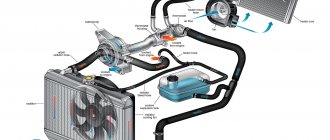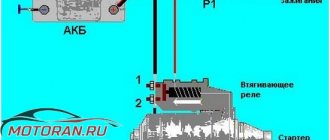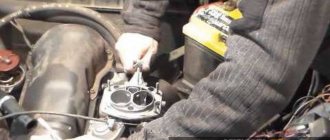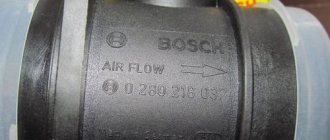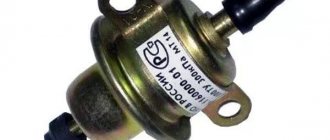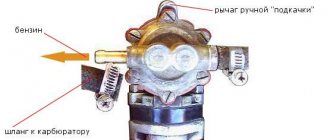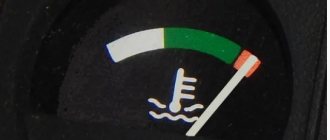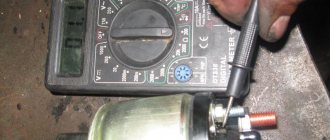Dima Kashevsky [kashevsky_dima]
04.10.2020,
I often encountered a problem when a VAZ would not start. Owners of injection and carburetor cars contacted us. Below I will list common causes that should help with your problem. Before that, it’s only worth saying that below we will talk about both old and new models. The material is voluminous, because I decided to describe everything in detail.
There are three main reasons why a domestic car does not want to start:
- Lack of fuel in the combustion chamber
- Lack of oxygen
- No ignition
As a rule, 80 percent of malfunctions lie in these three reasons. Let's take a closer look.
Ignition problems
The most common malfunction. The spark itself may exist, but its strength is not sufficient to ignite the fuel mixture. To identify the problem, the first step is to check the spark plugs.
In case anyone doesn't know, spark plugs can be found by the wide wires coming from them. We need to determine which candle has failed, because they cannot all break at once. To check, you need to start the VAZ engine and listen to the sound of its operation. Next, we unscrew the spark plugs one by one and listen to how the sound of the engine changes. When you remove a faulty spark plug, the sound of the engine will not change.
Inspect the unscrewed spark plug. By the carbon deposits on it you can determine why it failed. Most likely, the electrode will have one of the following deposits:
- Of red color. Occurs due to the addition of various additives to car fuel. If you see this type of carbon deposits, then you should refuse additives, because soon you will have to change the remaining spark plugs.
- White (similar to plaque). Indicates that the fuel mixture is unbalanced. This means that it is formed in the wrong oxygen/fuel ratio. There may be either an excess of fuel or an excess of oxygen.
- Matt black color. Occurs due to an excess of gasoline in the fuel mixture. Reason: the carburetor is incorrectly adjusted or the injector is not working correctly. Another symptom: increased fuel consumption.
- Oil black. Logically, this indicates increased oil consumption, which gets onto the electrode and interferes with the formation of a spark.
It is important to know! The spark plugs may be outwardly in good working order and the lack of a spark may be caused by filling the spark plug electrode with gasoline. This occurs due to a low battery charge.
The VAZ 2107 engine does not pick up speed and does not pull
It happens that the VAZ engine does not pull. This is most often due to low pressure in the rail. The engine starts normally, also idles stable, but does not pick up speed. The thing is that in such modes the fuel pump requires increased performance, which it cannot provide. If the VAZ engine does not run hot, then it is worth checking the air flow meter, as well as the spark plugs. The article already mentioned a red spark, but when cold, they can be normal, but under the influence of temperature they become “broken.”
Problems with starting a car engine can be divided into two main groups depending on the degree of engine heating.
Engine cold
From the moment the engine was turned off, at least 6 hours have passed at an outside temperature of +20 °C and at least 3 hours at –20 °C, the oil temperature in the engine crankcase coincides with the ambient temperature and to start the engine it is necessary to use the carburetor choke.
EXECUTION ORDEREngine is warm or hotThe oil temperature in the engine crankcase is higher than the ambient temperature and there is no need to use the carburetor choke to start the engine. Malfunctions in the starting systemMalfunctions in the starting system manifest themselves in abnormal operation of the starter. There are five main starter malfunctions: 1. The starter does not turn on. The reason is a violation of contact connections, a break or short circuit in the starter activation circuits, a malfunction of the additional starter activation relay, or a malfunction of the traction relay. 2.When the starter is turned on, multiple clicks are heard. The reason is a malfunction of the holding winding of the traction relay, the battery is severely discharged, and the contact connections in the starter circuit are loose. 3. The starter turns on, but its armature either does not rotate or rotates slowly. The reason is a discharged battery, broken contact connections, burnt contacts of the traction relay, dirty commutator or worn brushes, interturn or short circuit in the windings. 4. The starter turns on, its armature rotates, but the flywheel remains motionless. The reason is a weakening of the starter's attachment to the clutch housing, damage to the teeth of the flywheel or drive gear, slipping of the freewheel of the drive, breakage of the lever, drive ring or buffer spring of the starter drive. 5. The starter does not turn off after starting the engine. The reason is a malfunction of the starter freewheel, sintering of the contacts of the traction relay. In the event of such a malfunction, stop the engine immediately! 6. These malfunctions require qualified intervention from car service specialists. First, you can only check the degree of discharge of the battery using a voltmeter on the instrument panel and the tightness of the contact connections in the starter circuit. Checking the ignition systemYour vehicle is equipped with a high energy contactless ignition system. A voltage of about 40,000 V is supplied to the high-voltage wires, and although at low current levels it is not life-threatening, a possible electric shock when checking the ignition system can lead to serious consequences. Therefore, if you handle a high-voltage wire with the ignition on, use a thick rubber glove or, as a last resort, pliers with insulated handles. Before checking the ignition system, set the gear shift lever to neutral and leave the parking brake on. To check, you will need screwdrivers - slotted and Phillips, pliers with insulated handles and a tester or 12 V test lamp with two wires connected to it. You can also use a car carrier if you have one. |
Faulty starter
The problem with the starter on VAZs is very relevant. According to statistics, before a major overhaul of the engine, there is a need to repair the starter at least once. After checking the spark plugs, I advise you to pay attention to this mechanism and most likely the fault will lie there.
To determine the problem, you need to determine what type it is:
- Electric
- Mechanical
It is very easy to determine: if the starter does not turn and the VAZ does not start, then the problem is in the electrics. If you hear it spinning, then there is a mechanical problem. Let's figure out what can break down in the starter's electrics and what can go wrong in the mechanics.
Checking the contact.
Start checking with the simplest thing: inspecting the terminals on the mechanism body. Due to our “great” weather conditions, they like to oxidize, causing contact to be lost. As a result, the control impulse does not reach the motor and when we turn the ignition key we hear nothing. To clean the terminals, a regular fine knife or natfel will do.
Advice: to avoid corrosion of the terminals, you should treat them with lithol. It is first necessary to clean off any pockets of corrosion.
During the test, you will be able to confirm that there is no open circuit: each wire should be fixed to the starter terminals. Without diagrams on all VAZ models, the connection is similar:
- One “plus” from the battery goes to the starter terminal
- The second “plus” comes from the ignition switch through the fuse box
Check the fuse box, as a blown fuse breaks the circuit and no control voltage is supplied to the starter. Just visually check the fuse and if you see that it has burned out, replace it.
Checking the serviceability of the retractor
relay. This device is responsible for extending the bendix. Diagnosing a malfunction of the solenoid relay is easy, since it operates with a characteristic clicking sound.
A clicking sound appears when you turn the ignition key. If the solenoid relay does not click, then the problem lies with it or its fuse. Unfortunately, this part cannot be repaired, but it is inexpensive. By the way, there is a simple trick that often helps to revive a broken solenoid relay: you just tap it lightly with a hammer several times. In most cases this method works.
Broken Bendix gear teeth.
This is a rather rare type of reason why a VAZ will not start, but it is very easy to diagnose: an unpleasant metallic grinding sound will be heard from under the hood after turning the ignition key.
The problem is resolved by replacing the starter.
Another common reason why the starter does not turn and the VAZ does not start: a blown starter fuse. In this case, the solenoid relay does not click.
Electrical ignition system
The reason why the car engine does not start when trying to start the car when it is cold in the winter is a discharged battery. With each subsequent attempt to start the car in a similar situation, the battery is discharged and does not recharge.
There are two ways to check the battery:
- use a multimeter to measure the voltage between the terminals, the normal value of which is 12.6 V;
- measure the density using a hydrometer.
An almost discharged battery prevents the car from starting the engine in the winter when it is hot, that is, a heated car, and it may stall.
Electrical faults
The main technical malfunctions of this kind include the following:
- damage to the ignition switch mechanism;
- damage to the design of the ignition relay and (or) starter located under the hood;
- malfunction of the starter or retractor.
Fuel pump malfunction
With this malfunction, the Zhiguli engine starts, and then stalls or does not start at all. The first step is to check whether the fuel pump fuse is working properly, because according to statistics, 60 percent of VAZ fuel pump failures are associated with a blown fuse. In VAZ 2105 it is located in a block under the hood near the windshield, in VAZ 2107, 2109, 2115 in the cabin below the dashboard. In VAZ 2110, 2111 and 2112 it is located in the cabin in the place of the front passenger's feet. Next to the fuses there are relays, which are also responsible for the operation of the fuel pump. If the fault is not in the fuse or relay, then it lies either in the fuel pump itself or in its power supply circuit.
In carburetor VAZs, the fuel pump is located in the engine compartment next to the cylinder head.
All “classics” such as the Zhiguli were equipped with a fuel pump called DAAZ. Its catalog number is: 1106010. The part is very reliable, so the likelihood that the problem is with it is not high. And even if it breaks, you can buy repair kits.
In injection VAZs with a fuel pump, everything is not so fabulous.
It is hidden in the gas tank and likes to fail if there is little fuel inside. The pump motor is electric and is cooled by the gasoline itself, in which it is located. If there is little gasoline, the pump does not cool well, overheats and eventually breaks down.
The car may have difficulty starting due to low fuel content in the tank.
Checking the gasoline supply
You can indirectly determine the supply of gasoline to the cylinders by the appearance of the spark plug. If the spark plug removed from the cylinder is wet and smells of gasoline, then everything is fine with the fuel supply. However, it is better to make sure of this more reliably.
On injection engines, this requires relieving pressure in the fuel system using a special valve at the end of the fuel rail. Unscrew the cap and press the valve with a screwdriver. Gasoline should squirt out from under the valve. After this, release the valve and turn on the ignition. At this time, the fuel pump must start, restoring the released pressure in the system. If the pump is silent, turn on the starter. When the pump does not operate even when the starter is turned on, there is most likely a malfunction in its power supply system.
If the pump starts working, then we check the pressure in the fuel system again, releasing it through the same valve in the ramp. Splashing gasoline again indicates that everything is in order with the fuel supply system. When gasoline does not splash and does not appear from under the valve at all, we can talk about a faulty fuel pressure regulator in the rail (constantly bleeds gasoline through the return line into the tank) or some kind of plug in the main fuel line (for example, due to freezing of water in low-quality fuel ).
On carburetor engines, checking the fuel supply is much easier. It is enough to remove the air filter cover, move the throttle lever of the first chamber of the carburetor, simulating pressing the gas pedal, and see if gasoline sprays from the spray nozzle. You can pump gasoline into the carburetor using the manual pumping lever, which is found on all mechanical gasoline pumps.
Crankshaft position sensor
The sensor itself is very reliable, and there is nothing to break there. However, it can become clogged with a thick layer of dirt and stop functioning. The way out of the situation is simple: just wipe it. As a rule, it cannot become dirty immediately and the problem will manifest itself gradually: at first your VAZ does not start well, and after a month the car is no longer able to start.
Since a lot of dirt accumulates on this sensor, its contact with the wire simply rots. This is already a common problem, but it can be easily solved by manually restoring contact. The crankshaft sensor is located on the oil pump.
It is important to know! It is not permissible to make contact using twists. So you will lose it in a month, so it is best to solder the contact and cover it with lithol.
VAZ starts and immediately stalls
The car may stall immediately after starting, even due to trivial little things such as consumables. Therefore, first of all, I advise you to check the fuel and air filters. If they are clogged, it is difficult for the engine to receive oxygen and fuel, which causes it to simply stall.
If before your VAZ stopped starting, the following were discovered:
- Power Loss
- The car doesn't start well
- Increased fuel consumption
It is most likely that the catalyst that is equipped with VAZ injection models is faulty. The catalyst can be removed by flashing the engine control unit. As an alternative: install lambda decoys. A clogged catalyst may also be the reason why the VAZ does not start.
Checking distributor operation and troubleshooting
Often the car does not grip at all or does not hold idle speed well. Quite often the distributor on the VAZ 2106 fails. Procedure:
- you should check the gap size at the breaker contacts - the distance between them should be 0.4 mm;
- The integrity of the resistor is checked - it is located on a special slider.
If no problems were identified, then the ignition must be set correctly. All of the above malfunctions apply specifically to carburetor cars. But some VAZ 2106 models were equipped with injectors. The causes of malfunctions for different types of fuel injection systems can differ significantly.
